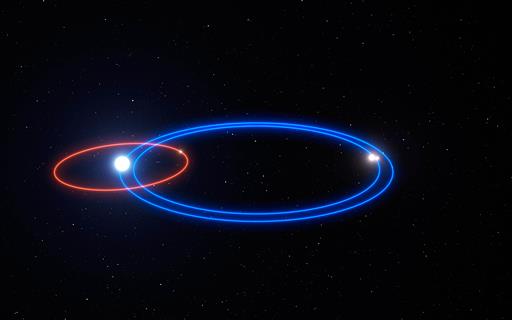Scientists discover strange planet with three stars

This image provided by the European Southern Observatory shows an illustration of the orbit of the gas giant planet in the HD 131399 system (red line) and the orbits of the three stars (blue lines). A University of Arizona-led team used an ESO telescope in Chile to find the system 320 light years away. The astronomers revealed their findings Thursday, July 7, 2016. (ESO via AP)
WASHINGTON—An international team of astronomers announced Thursday the discovery of a strange planet in a faraway solar system that contains not one sun, but three of them.
This distant world appears even more unusual than the home planet of Luke Skywalker in the Star Wars saga, Tatooine, which orbited around two suns, according to the findings published in the US journal Science.
Such binary solar systems may be relatively common in the universe, but experts say those involving three stars or more are rare.
“Imagine this: a planet where you’d either experience constant daylight or enjoy triple sunrises and sunsets each day, depending on the seasons, which happen to last longer than human lifetimes,” said a statement from the University of Arizona, which led the astronomy team.
The planet has been named HD 131399Ab, and it is located about 340 light years from Earth in the constellation Centaurus.
The cosmic body is believed to be relatively young, about 16 million years old, which makes it one of the youngest planets discovered outside our solar system to date.
Its mass is believed to be four times that of the gas giant Jupiter, which is our solar system’s largest planet.
It orbits the brightest of the three stars on a very long and wide path.
“For about half of the planet’s orbit, which lasts 550 Earth-years, three stars are visible in the sky, the fainter two always much closer together, and changing in apparent separation from the brightest star throughout the year,” said first author Kevin Wagner, a first-year PhD student who discovered HD 131399Ab.
“For much of the planet’s year the stars appear close together, giving it a familiar night-side and day-side with a unique triple-sunset and sunrise each day,” Wagner added.
“As the planet orbits and the stars grow further apart each day, they reach a point where the setting of one coincides with the rising of the other.”
The result is “near-constant daytime for about one-quarter of its orbit, or roughly 140 Earth-years.”
The astronomy team spotted the planet using the SPHERE instrument on the European Southern Observatory’s (ESO) Very Large Telescope in Chile.
SPHERE is one of the world’s most advanced instruments dedicated to finding planets around other stars.
SPHERE stands for Spectro-Polarimetric High-Contrast Exoplanet Research Instrument.
It is sensitive to infrared light, making it capable of detecting the heat signatures of young planets.
RELATED STORIES
NASA says 1,284 new planets found by Kepler telescope